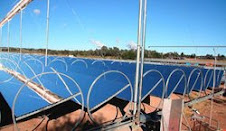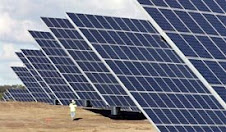Watch Tower: Green temples
from www.centralchronicle.com
Devotees can press the priests and authorities that run the big temples to use solar energy by installing photovoltaic panels in the large temple premises- Tukoji R Pandit
Temples and other religious places are an inalienable part of the Indian life. The more famous ones are also rich; Andhra Pradesh's Tirupati Balaji temple is believed to be the world's richest, receiving offerings worth millions of rupees from devotees. Most of the money is undoubtedly well spent on charities. But perhaps time has come when the rich and the famous temples actively contributed to green causes. The Tirupati temple can take up that cause more ardently since it has made a 'green' beginning by modernising its giant kitchen that perhaps churns out more 'laddus' in a day than a large shop in a metropolis.
An area where the temples in India can really make a significant contribution to green causes is in their kitchen, most of which seem to be still using wood and charcoal for preparing 'prasad' for the devotees when they can easily switch over to LPG-or solar power.
The temple kitchen at Rameshwaram, another famous temple, where devotees throng in large numbers, is still burning wood to run its kitchen. It is surely not difficult for the temple to go for solar energy in a big way. May be, the Sun Temple in Orissa could lead the way in honour of its name.
In the UK, a number of churches in places as far apart as Northern Ireland and Wales have switched over to solar panels for their electricity needs. And Britain is not known to be a particularly 'sunny' place on earth while most parts of India are blessed by plenty of sunshine: at times just too much of it, as in the deserts of Rajasthan.
Just recently in the tiny island of Cypress, the Greek Orthodox Church has announced that it will invest $234 million in the promotion of solar energy, building a factory to manufacture photovoltaic panels that capture the sun energy.
In the case of Cypress the initiative by the church had a sense of urgency about it because this year's heat wave in that Mediterranean island had soared electricity demand beyond the limits of all the power stations in the tiny country. The Cypriots face prospects of power cuts in 2008 if more electricity cannot be produced.
The power cut threats will hardly stir anyone in India since it is already the norm here. But the devotees can press the priests and authorities that run the big temples to use solar energy by installing photovoltaic panels in the (usually) large temple premises. If the electricity produced is more than the requirement of the temple concerned it could be sold to the grid-or, better, transmitted to the poorer sections in the town.
South Korea is doing that, though the solar electricity does not come from any Buddhist temple. The country is making 'solar apartments' for low-income group people. The country is also using garbage to produce methane gas that, perhaps appropriately, powers the garbage trucks.
The potential of solar energy in India is tremendous. In 15 minutes India can have a year's energy supply from the sun equal to the annual production of its nuclear power stations and power houses using conventional fossil fuels. It is believed photovoltaic panels spread over a slightly large area, 60x60 sq km, can generate 100,000 mw of solar energy.
It has been estimated that the unutilised solar energy that India receives is equal to 500 trillion kwh per annum. Scientists say that if even one percent of the national land is utilised for solar energy India could produce nearly 1000 giga watts of electricity. What this means can be judged from the fact that the current consumption in the country is about 120 giga watts, which is likely to more than triple within the next 25 years.
A factor that has prevented India from realising the full potential of its solar energy is the large initial cost even after the subsidies that the government offers in certain cases. Experts however say that the costs have come down substantially since the 1970s when a sudden spurt in oil prices had jolted much of the world to look for alternative, non-conventional sources of energy. The problem is the 'mindset' and government policies, which are loaded in favour of the conventional sources.
The large savings in electricity bills offset the heavy initial costs. Since the solar energy means no greenhouse gas emission the tremendous environmental advantage can hardly be emphasised, particular now when not a day passes when scientists are not making dark forebodings about an impending disaster because of global warming.
The government does have a plan to encourage non-conventional sources of energy, which has become all the more necessary in view of the astronomical rise in the price of petroleum and the supply uncertainties because of continued tension in West Asia. The government has plans to add 14,000 mw of solar power in the 11th Plan.
Indian scientists are talking about launching an indigenous 'hyperplane' in 2008 that will set up an Indian space power station for 24-hour supply, and not making strides in utilising solar energy. Take for instance the programme to install photovoltaic panels at traffic lights in Delhi and for lighting the billboards. It was announced with all seriousness about five years ago but all that one sees is chaos at traffic junctions the moment the supply from the grid fails. The plan to install solar panels at traffic junctions seems to have been abandoned because it is said it had become difficult to ensure their safety from vandals.
The developed world, after emitting greenhouse gases for 150 years without any concern for the environment, has now turned its attention to countries like India and China to paint then as environmental villains because of their huge gas emissions. Nearly half of India's energy comes from coal-based powerhouses. The country also imports nearly 70 percent of the petroleum that it needs to run its factories and the transport system.
While China has nearly displaces the US as the world's largest gas emitter, India is hurtling towards the second position, a dubious distinction. There is little choice before India than to go green and the temples with all their influence over the majority of population can serve a useful purpose by leading the way.
Solar Power Investing Blog
Best Green Stocks Investing Blog
Subscribe to:
Post Comments (Atom)
Yuya Joe Blog
Lake Ontario Waterkeeper
The Daily Beast -Politics Blog
21stArch.com - 21st Century Architecture
Original Joe College Blog
WikiLeaks Foreign Policy Analysis
AGreenRealtor.com Real Estate Blog - Ecology Energy Efficiency
Best Green Stocks Investing Blog
PV Intell Photovoltaic Solar Stocks Investing
SEARCH Leading Alternative Energy and Ethical Investing websites

Custom Search
Daily Kos
Rare Earth Stocks Research
Patrick MacManus's Blog Peace and Collaborative Development
BeesTreesFrogsElephants.com - Nature and Ecology Blog
Research Green Energy stocks, Clean Energy investing information
Find wind power investing info online, clean energy mutual funds, geothermal stocks, solar energy investments.

Green Energy Investing Network:
Green Stocks Investing Clean Power Blog
SolarIntell.com Renewable Power Investing Website
Wind Intell.com Wind Energy Stocks Company Links
Geothermal Power Investing Public Companies
PV Intell.com Leading Photovoltaic Solar Energy Stocks

Custom Search
Green Energy Investing Network:
Green Stocks Investing Clean Power Blog
SolarIntell.com Renewable Power Investing Website
Wind Intell.com Wind Energy Stocks Company Links
Geothermal Power Investing Public Companies
PV Intell.com Leading Photovoltaic Solar Energy Stocks







No comments:
Post a Comment